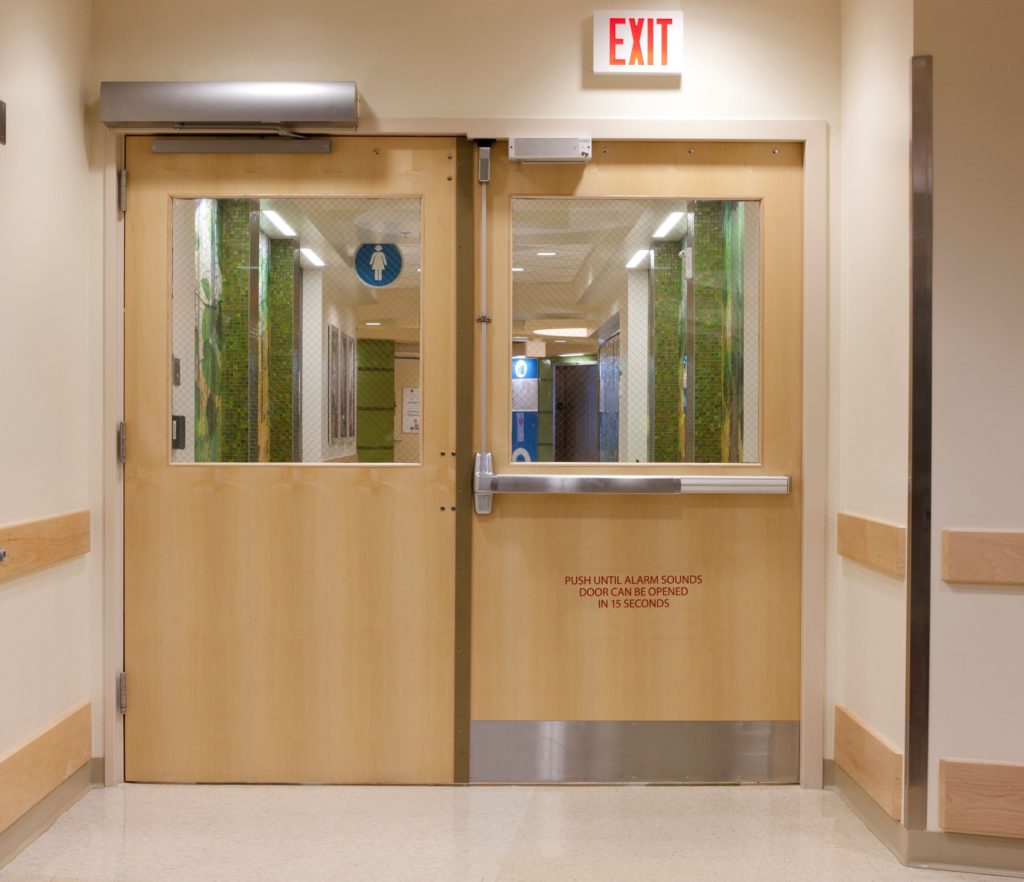 Back in the days when the BOCA National Building Code was adopted by many states in the Northeast, delayed egress locks were allowed to rearm automatically after the door was opened, closed, and remained closed for 30 seconds. In contrast with the old BOCA rules, the International Building Code (IBC) and NFPA 101 – The Life Safety Code require delayed egress locks to be rearmed manually. Today’s Quick Question is…
Back in the days when the BOCA National Building Code was adopted by many states in the Northeast, delayed egress locks were allowed to rearm automatically after the door was opened, closed, and remained closed for 30 seconds. In contrast with the old BOCA rules, the International Building Code (IBC) and NFPA 101 – The Life Safety Code require delayed egress locks to be rearmed manually. Today’s Quick Question is…
Does a delayed egress lock have to be rearmed manually after power failure and fire alarm release, or only when the 15-second timer is activated by an attempt to exit?
That question is not specifically answered in the model codes, but I don’t think the intent is to require manual rearm after power failure or fire alarm. An AHJ could disagree but I haven’t seen this required by any AHJs on past projects.
The IBC only references manual rearm in the section that describes the requirements for allowing egress after 15 seconds (not in the sections on fire alarm or power failure release):
An attempt to egress shall initiate an irreversible process that shall allow such egress in not more than 15 seconds when a physical effort to exit is applied to the egress side door hardware for not more than 3 seconds. Initiation of the irreversible process shall activate an audible signal in the vicinity of the door. Once the delay electronics have been deactivated, rearming the delay electronics shall be by manual means only.
The NFPA 101 requirements are similar – the requirement for manual rearm is specified only in the paragraph on activation/deactivation of the device by an attempt to egress – not by fire alarm or power failure. Neither the IBC Commentary nor the NFPA Handbook, explain why manual rearm is required, but my understanding is that someone must go to the door to verify that all is well rather than just pushing a button from a remote location or having the access control system automatically rearm the door. If this is the purpose of the requirement, it would not be important to visit the door when the cause of the deactivation was power failure or fire alarm, or when there is authorized egress via card reader, keypad, etc.
What do you think?
~~~
Related Posts:
You need to login or register to bookmark/favorite this content.






I’m guessing the intent is to prevent the door from rearming itself after it has been activated to allow additional (but latter arriving) occupants to egress. If someone arrives 16 seconds after the door closed they would have to wait an additional 15 seconds instead of being able to leave immediately. Which could seem an eternity with fire alarms and sprinkers going off.
Seems like with power loss or fire alarm activation,
You can walk up to the door and just walk out without any delay.
Once power is on or the fire alarm is reset,,
The entire system operation is back to normal operation.
I have installed several of these nasty devices and have always met with the AHJ during planning and before final completion. We always include the AHJ in the final inspection of the device or system. We have always maintained that a fire alarm reset after activation does not necessarily mean that the fire department or emergency response personnel are finished using the door. We have always required a manual reset at the door. We always install battery backup for these doors to maintain control for some amount of time if there is a power failure. If there was a short term power failure with no fire alarm activation, the door should not have unlocked. Power failure alone should not trip the fire alarm system, but it is proper for the system to monitor, and maybe report, AC power loss and to maintain protection during power loss. We NEVER allow remote or automatic reset after an attempted egress. This is very specific in the code and lazy people would just not bother to go check the door for a problem.
I was (and still are) of the belief that the requirement to manually rearm the system in all cases, all circumstances, was to ensure that only knowledgeable personnel with authority (owner or representative) coul rearm the system so that, for example, a defective fire alarm panel or a a fire alarm undergoing test or modification, would not compromise the operation of the locking mechanism. Remember, you are locking the doors, you better be sure of what you are doing
from a security standpoint, if the door is supposed to be secured, it needs manual inspection to confirm relatching, as an automatic release could be used to facilitate future access.
e.g. I have limited access but want access at another time, or w/o setting off the alarm. I bump the handle, wait 15 seconds, I quickly watergate the latch, and immediately walk over to security to tell them that I bumped it. They remote clear the alarm, and I or anyone else is now free to use that door w/o the egress alarm. If security had to walk back over and look at the latch, they’d see my tape and know something was amis.
The first reply is in line with what I read during code discussions many years ago. It seems to me I remember an incident where the constant relocking extended evacuation time of randomly arriving occupants by a few minutes. I think I read that in the technical discussion documents on Life Safety Code.
I always believed the intent of the obligatory manual rearm was to make sure that only knowledgeable and authorized personnel (owner, representative, authority) would re-established the locking mechanism after any event. An automatic rearming might be slightly risky in certain circumstances. For example ; a down fire control panel or not able to rearm properly, a control panel under maintenance or otherwise disabled.
Keep in mind that we are delaying egress, a big no-no, so somebody as to make sure that everything is back to normal before rearming the locks.
Ohhhhhh boy. That wired glass in the picture is an accident waiting to happen.